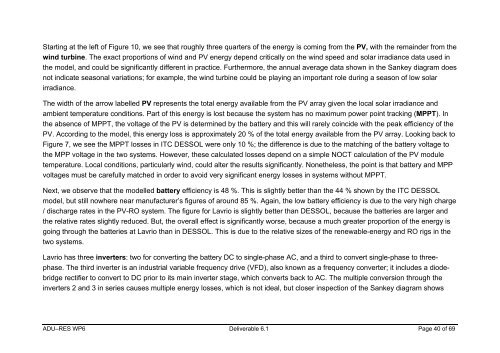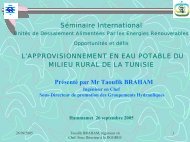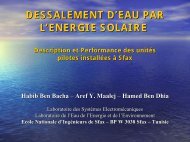Energy consumption modelling - ADU-RES
Energy consumption modelling - ADU-RES
Energy consumption modelling - ADU-RES
You also want an ePaper? Increase the reach of your titles
YUMPU automatically turns print PDFs into web optimized ePapers that Google loves.
Starting at the left of Figure 10, we see that roughly three quarters of the energy is coming from the PV, with the remainder from the<br />
wind turbine. The exact proportions of wind and PV energy depend critically on the wind speed and solar irradiance data used in<br />
the model, and could be significantly different in practice. Furthermore, the annual average data shown in the Sankey diagram does<br />
not indicate seasonal variations; for example, the wind turbine could be playing an important role during a season of low solar<br />
irradiance.<br />
The width of the arrow labelled PV represents the total energy available from the PV array given the local solar irradiance and<br />
ambient temperature conditions. Part of this energy is lost because the system has no maximum power point tracking (MPPT). In<br />
the absence of MPPT, the voltage of the PV is determined by the battery and this will rarely coincide with the peak efficiency of the<br />
PV. According to the model, this energy loss is approximately 20 % of the total energy available from the PV array. Looking back to<br />
Figure 7, we see the MPPT losses in ITC DESSOL were only 10 %; the difference is due to the matching of the battery voltage to<br />
the MPP voltage in the two systems. However, these calculated losses depend on a simple NOCT calculation of the PV module<br />
temperature. Local conditions, particularly wind, could alter the results significantly. Nonetheless, the point is that battery and MPP<br />
voltages must be carefully matched in order to avoid very significant energy losses in systems without MPPT.<br />
Next, we observe that the modelled battery efficiency is 48 %. This is slightly better than the 44 % shown by the ITC DESSOL<br />
model, but still nowhere near manufacturer’s figures of around 85 %. Again, the low battery efficiency is due to the very high charge<br />
/ discharge rates in the PV-RO system. The figure for Lavrio is slightly better than DESSOL, because the batteries are larger and<br />
the relative rates slightly reduced. But, the overall effect is significantly worse, because a much greater proportion of the energy is<br />
going through the batteries at Lavrio than in DESSOL. This is due to the relative sizes of the renewable-energy and RO rigs in the<br />
two systems.<br />
Lavrio has three inverters: two for converting the battery DC to single-phase AC, and a third to convert single-phase to threephase.<br />
The third inverter is an industrial variable frequency drive (VFD), also known as a frequency converter; it includes a diodebridge<br />
rectifier to convert to DC prior to its main inverter stage, which converts back to AC. The multiple conversion through the<br />
inverters 2 and 3 in series causes multiple energy losses, which is not ideal, but closer inspection of the Sankey diagram shows<br />
<strong>ADU</strong>–<strong>RES</strong> WP6 Deliverable 6.1 Page 40 of 69







